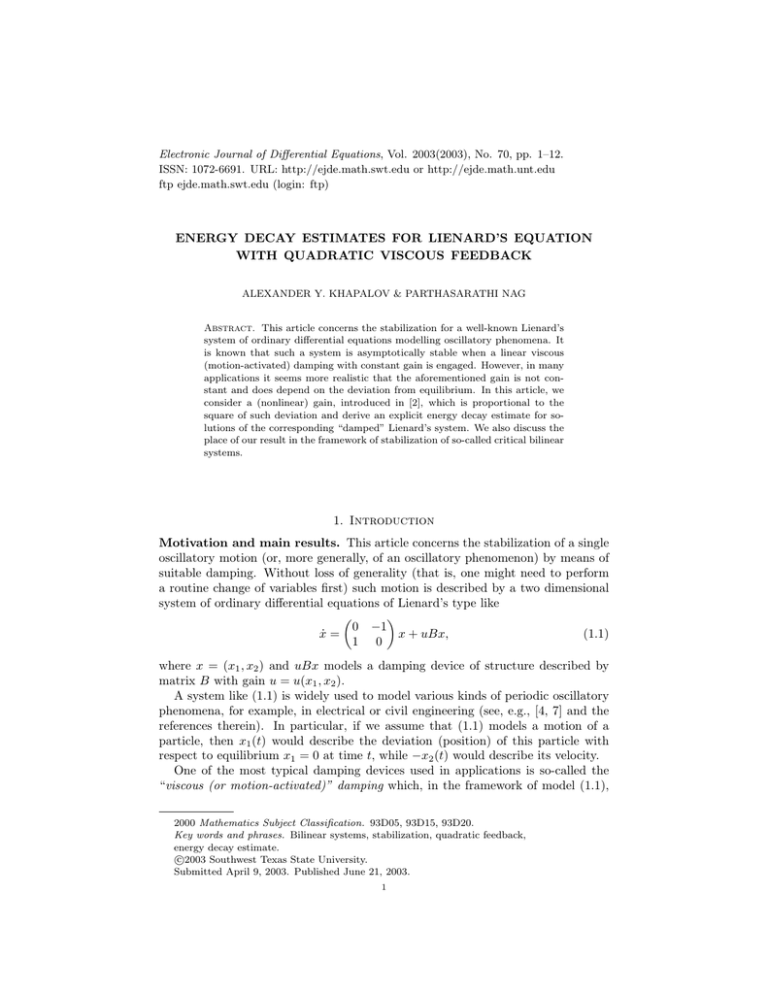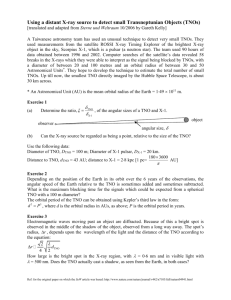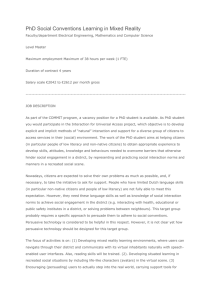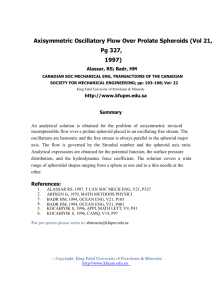Electronic Journal of Differential Equations, Vol. 2003(2003), No. 70, pp.... ISSN: 1072-6691. URL: or
advertisement

Electronic Journal of Differential Equations, Vol. 2003(2003), No. 70, pp. 1–12.
ISSN: 1072-6691. URL: http://ejde.math.swt.edu or http://ejde.math.unt.edu
ftp ejde.math.swt.edu (login: ftp)
ENERGY DECAY ESTIMATES FOR LIENARD’S EQUATION
WITH QUADRATIC VISCOUS FEEDBACK
ALEXANDER Y. KHAPALOV & PARTHASARATHI NAG
Abstract. This article concerns the stabilization for a well-known Lienard’s
system of ordinary differential equations modelling oscillatory phenomena. It
is known that such a system is asymptotically stable when a linear viscous
(motion-activated) damping with constant gain is engaged. However, in many
applications it seems more realistic that the aforementioned gain is not constant and does depend on the deviation from equilibrium. In this article, we
consider a (nonlinear) gain, introduced in [2], which is proportional to the
square of such deviation and derive an explicit energy decay estimate for solutions of the corresponding “damped” Lienard’s system. We also discuss the
place of our result in the framework of stabilization of so-called critical bilinear
systems.
1. Introduction
Motivation and main results. This article concerns the stabilization of a single
oscillatory motion (or, more generally, of an oscillatory phenomenon) by means of
suitable damping. Without loss of generality (that is, one might need to perform
a routine change of variables first) such motion is described by a two dimensional
system of ordinary differential equations of Lienard’s type like
0 −1
ẋ =
x + uBx,
(1.1)
1 0
where x = (x1 , x2 ) and uBx models a damping device of structure described by
matrix B with gain u = u(x1 , x2 ).
A system like (1.1) is widely used to model various kinds of periodic oscillatory
phenomena, for example, in electrical or civil engineering (see, e.g., [4, 7] and the
references therein). In particular, if we assume that (1.1) models a motion of a
particle, then x1 (t) would describe the deviation (position) of this particle with
respect to equilibrium x1 = 0 at time t, while −x2 (t) would describe its velocity.
One of the most typical damping devices used in applications is so-called the
“viscous (or motion-activated)” damping which, in the framework of model (1.1),
2000 Mathematics Subject Classification. 93D05, 93D15, 93D20.
Key words and phrases. Bilinear systems, stabilization, quadratic feedback,
energy decay estimate.
c
2003
Southwest Texas State University.
Submitted April 9, 2003. Published June 21, 2003.
1
2
A. Y. KHAPALOV & P. NAG
EJDE–2003/70
is associated with the matrix
B=
0
0
0
1
and a negative gain u, in which case system (1.1) looks as follows:
ẋ1 = −x2 , t > 0,
ẋ2 = x1 + ux2 ,
(1.2)
x1 (0) = x10 , x2 (0) = x20 .
(1.3)
Note that the damping term in (1.2) is active only when the “velocity” x2 (t) is not
zero and it “acts” in the direction which is opposite of the “motion of the particle”
at any given time t.
It is classical result that system (1.2)–(1.3) is asymptotically stable when a linear
viscous damping with a negative constant gain is engaged, that is, when u in (1.2)
is a negative number. (Note that in this case one can obtain the explicit formula
for solutions.) However, it seems more realistic in many applications that the
aforementioned gain u should depend on deviation from equilibrium. In this respect
we refer the reader to Jurdjevic and Quinn [4] who considered the quadratic gain
u(x1 , x2 ) = −x21 ,
(1.4)
in which case the gain is proportional to the square of the magnitude of deviation.
It was shown in [4] that system (1.2)–(1.4) is asymptotically stable. On the other
hand, the method of [4] does not provide any explicit estimates for the energy
decay of the corresponding solutions, which evaluate the effectiveness of nonlinear
feedback (1.4) and thus are of principal importance in applications.
The main goal of this paper is to derive such an explicit energy decay estimate
for system (1.2)–(1.4). It is clear from the start that it cannot be of exponential
type, because system (1.2)–(1.4) is critical (see the discussion in the next section
for details). We have the following result.
Theorem 1.1. There exist positive constants β, γ, and t̄ = t̄(k (x10 , x20 ) kR2 ) such
that the energy
x2 (t) + x22 (t)
E(t) = 1
2
of system (1.2)–(1.4) satisfies
E(t) ≤
E(0)
,
β + γE(0)t
t > t̄.
(1.5)
The values of the constants β and γ are given in the proof of this theorem (see
(2.69) below).
Problem background: Critical bilinear systems. System (1.2)–(1.4) (or (1.1))
is an important principal case of planar, so-called critical bilinear systems (BLS),
which are of traditional interest in the context of asymptotic stabilization (see, e.g.,
[2] for more detail). Let us remind the reader that a planar BLS of the form
ẋ = Ax + u(x1 , x2 )Bx, x(0) = x0 ,
(1.6)
is called critical if the given matrices A and B satisfy the following two conditions:
• For each u? ∈ R at least one eigenvalue of A + u? B has nonnegative real
part.
EJDE–2003/70
LIENARD’S EQUATION WITH QUADRATIC VISCOUS FEEDBACK
3
• There exists a u0 ∈ R for which all the real parts of the eigenvalues of
A + u0 B are non positive.
Note that the latter condition implies that system (1.6) is stable when the constant
feedback u(x1 , x2 ) = u0 is engaged, while the former condition implies that (1.6) is
not asymptotically stabilizable by any constant feedback.
It is well-known (e.g., [2]) that, by the standard linear change of coordinates and
time-rescaling, all the matrices A satisfying the above-cited two conditions can be
transformed either into the matrix
0 −1
1 0
as our matrix A in (1.1) or in (1.2)–(1.4), associated with a periodic oscillatory
motion, or into one of the following three “simpler” matrices:
0 0
0 0
0 1
,
,
.
0 0
0 −1
0 0
We refer the reader to [1, 2, 3, 5] for various positive and negative results on
stabilization of planar critical BLS by means of constant, linear, quadratic and
piecewise constant feedback laws. However, it seems that all the available results
do not provide any explicit energy decay rates.
x2
A3
q1
A2
I’
r1 p1
II
A4
I
qo A1
IV’
p2
II’
x1
O
A5
A8
q2
III
p3
q3
IV
III’
A6
A7
Figure 1. Trajectory for system (1.2)–(1.4)
2. Proof of Theorem 1.1
Our plan for this section as follows: First of all, as we are concerned with the
large time behavior of (1.2)–(1.4), without loss of generality (see Step 8 for the
4
A. Y. KHAPALOV & P. NAG
EJDE–2003/70
general case), we can assume that
1
}.
(2.1)
2
Select any angle θ0 ∈ (0, π4 ) and split the ball B into eight sectors I, I,0 II, II,0
III, III 0 and IV,IV 0 as shown on Figure 1, so that the central angles ∠A1 OA8 ,
∠A2 OA3 , ∠A4 OA5 and ∠A6 OA7 are all equal to 2θ0 . Again, without loss of
generality, we may assume that the initial point (x10 , x20 ) is located at point A1 ,
also denoted by q0 on Figure 1 (see Step 8 otherwise), where respectively the solid
line starting from q0 describes the trajectory (x1 (t), x2 (t)) of system (1.2)–(1.4) as
it crosses all the eight aforementioned sectors.
Our plan is to derive the energy decay estimate for the solution to (1.2)–(1.4)
starting from q0 by evaluating its energy subsequently in each of the above mentioned sectors I − IV 0 . Then we extend this result to the general case.
{(x10 , x20 )} ⊂ B = {(ξ, η)|ξ 2 + η 2 ≤
Remark 2.1. Below we use the notation x1 = x1 (t), x2 = x2 (t), keeping in mind
that (x1 , x2 ) = (x1 (t), x2 (t)) represent the solution to (1.2)–(1.4) at hand.
Step 1: Denote by tp1 the time required for the trajectory of (1.2)–(1.4) starting
from q0 = (x1 (0), x2 (0)) = (x10 , x20 ) to reach point p1 . We have (see Figure 1):
q
p
x1 (t) ≥ 2E(tp1 ) sin(θ0 ), x2 (t) ≥ 2E(0) sin(θ0 )
(2.2)
and hence
x21 (t)x22 (t) ≥ 4E(0)E(tp1 ) sin4 (θ0 ).
(2.3)
Multiplying equations (1.2)–(1.4) respectively by x1 and x2 and adding them, we
obtain:
1 d k x(t) k2R2
dE(t)
=
= −x21 (t)x22 (t).
(2.4)
x1 (t)x˙1 (t) + x2 (t)x˙2 (t) =
dt
2
dt
Integrating this equation over (0, tp1 ) yields:
Z tp1
x21 (tp1 ) + x22 (tp1 )
=−
x21 x22 dt + E(0).
(2.5)
E(tp1 ) =
2
0
Applying (2.3) (2.5), we obtain
E(tp1 ) ≤ E(0) − 4E(0)E(tp1 ) sin4 (θ0 )tp1 ,
(2.6)
which yields:
E(tp1 ) ≤
E(0)
,
1 + 4E(0)δ 2 tp1
(2.7)
where δ = sin2 (θ0 ). Thus, to estimate E(tp1 ), we need to evaluate tp1 . This evaluation is accomplished in steps 2-4 below, based on the “visualization technique,” [5]
which makes use of the phase-portrait of system (1.2)–(1.4). Namely, to evaluate
tp1 , we intend to derive first explicit estimates both (a) for the length of arc of the
trajectory of (1.2)–(1.4) lying in sector I and (b) for the speed at which the point
describing the position of system (1.2)–(1.4) at time t moves along this arc. These
estimates, obtained in terms of the energy function, will provide us with the bounds
for the duration of the time-interval required by the system to traverse sector I,
that is, for tp1 . It turns out that the derived bounds for tp1 , do not depend on the
energy of the system in sector I.
EJDE–2003/70
LIENARD’S EQUATION WITH QUADRATIC VISCOUS FEEDBACK
5
Remark 2.2. From (2.4) we conclude that the distance k x(t) kR2 monotonically
decreases as t → ∞. This in turn implies that the trajectory initiated at q0 remains
in B for all t > 0. In other words, system (1.2)–(1.4) is stable (see also [4]).
p
2
Step 2: Estimate for x˙1 (t)2 +
qx˙2 (t) in sector I. In this step we obtain an
estimate for the value of the speed x˙1 2 (t) + x˙2 2 (t) at which the point (x1 (t), x2 (t))
moves in sector I. Since (x1 , x2 ) ∈ B, in sector I we have
1
1
1
and x1 x2 ≤ .
(2.8)
0 < x1 ≤ √ , 0 < x2 ≤ √
2
2
2
Hence, using (1.2) and applying (2.8),
x1
x˙1 = −x2 , x˙2 = x1 − x21 x2 = x1 (1 − x1 x2 ) ≥
.
(2.9)
2
Therefore, from (2.9) we derive:
x21
x2 + x22
E(t)
+ x22 ≥ 1
=
.
4
4
2
Since Ė(t) ≤ 0, in view of (2.10), we have the following estimates:
r
p
q
E(tp1 )
E(t)
2
2
√
≥
x˙1 (t) + x˙2 (t) ≥
, t ∈ [0, tp1 ].
2
2
x˙1 2 + x˙2 2 ≥
(2.10)
(2.11)
Applying the triangular inequality to the second equation in (1.2) and using (2.8),
we obtain:
|x1 (t)|
3|x1 (t)|
|x˙2 (t)| = |x1 (t) − x21 (t)x2 (t)| ≤ |x1 (t)| + x21 (t)|x2 (t)| ≤ |x1 (t)| +
=
.
2
2
(2.12)
Remark 2.3. Note that inequalities (2.10)–(2.12) hold everywhere in B.
Using (2.12) and the first equation in (1.2), we further derive that for t ∈ [0, tp1 ],
r
r
p
q
3 E(0)
9x21 (t)
9(x21 (t) + x22 (t))
2
2
2
√
. (2.13)
x˙1 (t) + x˙2 (t) ≤
+ x2 (t) ≤
≤
4
4
2
Combining equations (2.11) and (2.13) yields
p
p
q
E(tp1 )
3 E(0)
2
2
√
√
≤ x˙1 (t) + x˙2 (t) ≤
, t ∈ [0, tp1 ].
(2.14)
2
2
These estimates will be used to evaluate tp1 in step 4 below.
Step 3: Estimate for |q0 p1 |. In this step we obtain an estimate for the length of the
curve q0 p1 connecting the points q0 and p1 (see Figure 1). It follows from (2.8) and
(2.9) that the curve q0 p1 is rising as t increases in [0, tp1 ]. Hence, we can describe
it geometrically
as a graph
p of some monotone decreasing function x2 = x2 (x1 ),
p
x1 ∈ [ 2E(tp1 ) sin(θ0 ), 2E(0) cos(θ0 )] and
Z √2E(0) cos(θ0 ) r
dx2 2
|q0 p1 | = √
1+(
) dx1 .
(2.15)
dx1
2E(tp1 ) sin(θ0 )
Using the first equation of (1.2) and the fact that x˙2 (t) is strictly positive on the
interval t ∈ [0, tp1 ], we have from (2.12):
x˙1 = −x2 (t), x˙2 ≤
3x1 (t)
.
2
(2.16)
6
A. Y. KHAPALOV & P. NAG
EJDE–2003/70
Note that in sector I, x1 (t) and x2 (t) are both positive, while x˙1 (t) is strictly
negative. Hence,
x˙2
3x1 (t)
≤
, t ∈ [0, tp1 ].
(2.17)
−x˙1
2x2 (t)
Therefore, [8, pp.105], we conclude that
|
dx2
3x1 (t)
|<
, t ∈ [0, tp1 ].
dx1
2x2 (t)
(2.18)
Thus,
dx2 2
9(x21 (t) + x22 (t))
9E(t)
) ≤
= 2 , t ∈ [0, tp1 ].
(2.19)
dx1
4x22 (t)
2x2 (t)
Using (2.19) and the fact that E(t) is a decreasing function of t, we further obtain
that
p
r
3 E(0)
9E(0)
dx2 2
dx2 2
1+(
) ≤
or
1+(
) ≤ √
, t ∈ [0, tp1 ].
(2.20)
dx1
2x2 (t)2
dx1
2x2 (t)
1+(
Since x˙2 (t) is strictly positive,
q
q
p
2E(0) sin(θ0 ) ≤ x2 (t) ≤ 2E(tp1 ) cos(θ0 ) ≤ 2E(tp1 ),
Applying (2.21) to (2.20) gives
r
dx2 2
3
1+(
) ≤
,
dx1
2 sin(θ0 )
t ∈ [0, tp1 ].
t ∈ [0, tp1 ] .
(2.21)
(2.22)
Remark 2.4. Note that, in view of Remark 2.1, inequality (2.22) also holds in
sector I 0 , namely in the portion that lies in the first quadrant.
Combining (2.15) with (2.22) yields:
Z √2E(0) cos(θ0 ) r
dx2 2
1+(
) dx1
|q0 p1 | = √
dx1
2E(tp1 ) sin(θ0 )
p
p
3( 2E(0) cos(θ0 ) − 2E(tp1 ) sin(θ0 ))
≤
.
2 sin(θ0 )
(2.23)
Moreover, since E(0) > E(tp1 ) and cos(θ0 ) ≥ sin(θ0 ) for any θ0 ∈ [0, π4 ], further
from (2.23), we obtain
p
Z √2E(0) cos(θ0 ) r
3 E(0)
dx2 2
|q0 p1 | = √
1+(
) dx1 ≤ √
.
(2.24)
dx1
2 sin(θ0 )
2E(tp1 ) sin(θ0 )
We shall now evaluate the length of the curve q0 p1 from below. Once again, (2.9)
yields
x˙2
dx2
x1 (t)
=|
|≥
, t ∈ [0, tp1 ].
(2.25)
−x˙1
dx1
2x2 (t)
Therefore,
1+(
dx2 2
4x2 (t) + x22 (t)
x21 (t) + x22 (t)
) ≥ 1
≥
,
dx1
4x2 (t)2
4x2 (t)2
Applying (2.24) to this inequality, we obtain
p
r
E(tp1 )
dx2 2
,
1+(
) ≥ √
dx1
2x2 (t)
t ∈ [0, tp1 ].
t ∈ [0, tp1 ].
(2.26)
EJDE–2003/70
LIENARD’S EQUATION WITH QUADRATIC VISCOUS FEEDBACK
Combining (2.21) with (2.26) yields
r
dx2 2
1
1+(
) ≥ ,
dx1
2
t ∈ [0, tp1 ].
7
(2.27)
Applying (2.27) to (2.15), we obtain the following estimate for the length of the
curve q0 p1 from below:
Z √2E(0) cos(θ0 ) r
dx2 2
|q0 p1 | = √
1+(
) dx1
dx1
2E(tp1 ) sin(θ0 )
(2.28)
p
p
( 2E(0) cos(θ0 ) − 2E(tp1 ) sin(θ0 ))
Kp
E(0),
≥√
≥
2
2
where K = cos(θ0 ) − sin(θ0 ). Combining (2.24) and (2.28), we finally obtain:
p
3 E(0)
Kp
√
≥ |q0 p1 | ≥ √
E(0).
(2.29)
2 sin(θ0 )
2
Step 4: Estimate for tp1 . In this step we shall derive an estimate for tp1 , i.e., the
time required for the trajectory of (1.2)–(1.4), initiated at q0 , to reach the point p1 .
We begin by computing the lower bound estimate for tp1 . Making use of (2.14)and
(2.29), we obtain that
p
Z tp1 q
3 E(0)
Kp
2
2
√
√
E(0) ≤ |q0 p1 | =
x˙1 (t) + x˙2 (t)dt ≤
tp1 ,
(2.30)
2
2
0
which in turn yields:
K
≤ tp1 .
(2.31)
3
Analogously, it follows from (2.14) and (2.29) that
p
p
Z tp1 q
E(tp1 )
3 E(0)
2
2
√
tp1 ≤ |q0 p1 | =
,
(2.32)
x˙1 (t) + x˙2 (t)dt ≤ √
2
2 sin(θ0 )
0
which implies
p
3 E(0)
p
.
tp1 ≤
sin(θ0 ) E(tp1 )
Combining (2.31) and (2.33) yields
p
3 E(0)
K
p
≤ tp1 ≤
.
3
sin(θ0 ) E(tp1 )
(2.33)
(2.34)
Since x˙2 (t) is strictly positive in sector I, we have x2 (tp1 ) ≥ x2 (0). Hence,
x21 (tp1 ) + x22 (tp1 )
x2 (tp )
x2 (0)
≥ 1 1 ≥ 2
= E(0) sin2 (θ0 )
2
2
2
(see Figure 1), which implies that
s
E(0)
1
≤
.
E(tp1 )
sin(θ0 )
E(tp1 ) =
(2.35)
Applying inequality (2.35) to (2.34) yields:
K
3
.
≤ tp1 ≤
3
sin2 (θ0 )
(2.36)
8
A. Y. KHAPALOV & P. NAG
EJDE–2003/70
Step 5: Estimate for the time taken by the trajectory of (1.2)–(1.4) to
pass sectors I and I 0 . In this step we shall derive an estimate for tq1 , i.e., for the
time required by the trajectory of (1.2)–(1.4), initiated at q0 , to reach point q1 (see
Figure 1). Split the trajectory in sector I 0 into two arcs p1 r1 and r1 q1 (see Figure
1). Denote the time required by the trajectory of (1.2)–(1.4) to connect the points
p1 and r1 by tp1 r1 and the time required to connect the points r1 and q1 by tr1 q1 .
Step 5.1: Estimate for time tp1 r1 . The arc
p p1 r1 can be described geometrically
as a graph of function x2 = x2 (x1 ), x1 ∈ [0, 2E(tp1 ) sin(θ0 )]. Then, applying the
inequality (2.22) (see Remarks 2.1 and 2.4) to (2.37) in sector I 0 , we obtain
p
p
Z √2E(tp1 ) sin(θ0 ) r
3 2E(tp1 ) sin(θ0 )
3 E(tp1 )
dx2 2
√
.
|p1 r1 | =
) dx1 ≤
≤
1+(
dx1
2 sin(θ0 )
2
0
(2.37)
Since Ė(t) < 0 for any time t ∈ [tp1 , tp1 + tp1 r1 ], we have from (2.10),
r
p
p
q
E(tp1 + tp1 r1 )
E(t)
x21 (t) + x22 (t)
2
2
√
≥
.
(2.38)
= √
x˙1 (t) + x˙2 (t) ≥
4
2
2
Hence, in view of (2.37),
p
p
Z tp1 +tp1 r1 q
E(tp )
E(tp1 + tp1 r1 )
2
2
√
tp1 r1 ≤ |p1 r1 | =
x˙1 (t) + x˙2 (t)dt ≤ 3 √ 1 ,
2
2
tp1
(2.39)
which yields
p
3 E(tp1 )
tp1 r1 ≤ p
.
(2.40)
E(tp1 + tp1 r1 )
Since x˙2 (t) is positive, we have x2 (tp1 + tp1 r1 ) ≥ x2 (tp1 ). Hence,
E(tp1 + tp1 r1 ) =
x2 (tp )
x22 (tp1 + tp1 r1 )
≥ 2 1 = E(tp1 ) cos2 (θ0 ),
2
2
which implies
s
E(tp1 )
1
≤
.
E(tp1 + tp1 r1 )
cos(θ0 )
(2.41)
Finally, combining (2.40) and (2.41), we obtain the following estimate for tp1 r1 ,
tp1 r1 ≤
3
.
cos(θ0 )
(2.42)
Step 5.2: Estimate for the time tr1 q1 . Once again, the arc r1 q1 can be described
geometrically
as the graph of a function x2 = x2 (x1 ), with x1 in the interval
p
[− 2E(tp1 + tp1 r1 + tr1 q1 ) sin(θ0 ), 0]. Then
r
Z 0
dx2 2
|r1 q1 | = √
1+(
) dx1 .
(2.43)
dx1
− 2E(tp1 +tp1 r1 +tr1 q1 ) sin(θ0 )
Note that x1 (t), x˙1 (t), and x˙2 (t) are strictly negative on the interval t ∈ [tp1 +
tp1 r1 , tp1 + tp1 r1 + tr1 q1 ], where x2 (t) is positive. Since it follows from (1.2)–(1.4)
and (2.12) (see Remark 2.3) that
−x˙2 ≤ −
3x1
2
and x˙1 = −x2 ,
EJDE–2003/70
LIENARD’S EQUATION WITH QUADRATIC VISCOUS FEEDBACK
9
we have
0≤
x˙2
3x1 (t)
≤
,
x˙1
−2x2 (t)
t ∈ [tp1 + tp1 r1 , tp1 + tp1 r1 + tr1 q1 ].
(2.44)
Therefore,
1+(
9(x21 (t) + x22 (t))
dx2 2
9E(t)
) ≤
≤ 2 ,
dx1
4x22 (t)
2x2 (t)
t ∈ [tp1 +tp1 r1 , tp1 +tp1 r1 +tr1 q1 ]. (2.45)
Using (2.45) and the fact that E(t) is a decreasing function of t, we obtain
p
r
3 E(tp1 + tp1 r1 )
dx2 2
√
.
(2.46)
1+(
) ≤
dx1
2x2 (t)
Since x˙2 (t) is strictly negative, for t in [tp1 + tp1 r1 , tp1 + tp1 r1 + tr1 q1 ],
q
q
2E(tp1 + tp1 r1 + tr1 q1 ) cos(θ0 ) ≤ x2 (t) ≤ 2E(tp1 + tp1 r1 ).
Applying (2.47) to (2.46) gives
p
r
3 E(tp1 + tp1 r1 )
dx2 2
1+(
) ≤√ p
,
dx1
2 2E(tp1 + tp1 r1 + tr1 q1 ) cos(θ0 )
(2.47)
(2.48)
for t ∈ [tp1 + tp1 r1 , tp1 + tp1 r1 + tr1 q1 ]. Thus applying inequality (2.48) to (2.43), we
obtain an upper estimate for the length of the arc r1 q1 :
r
Z 0
dx2 2
1+(
) dx1
|r1 q1 | = √
dx1
− 2E(tp1 +tp1 r1 +tr1 q1 ) sin(θ0 )
(2.49)
p
3 2E(tp1 + tp1 r1 ) tan(θ0 )
√
≤
.
2
Since Ė(t) < 0 for any t ∈ [tp1 + tp1 r1 , tp1 + tp1 r1 + tr1 q1 ], making use of (2.10) (see
Remark 2.3), we derive that
r
p
q
E(tp1 + tp1 r1 + tr1 q1 )
x21 (t) + x22 (t)
2
2
√
≥
.
(2.50)
x˙1 (t) + x˙2 (t) ≥
4
2
Using inequalities (2.49) and (2.50), we obtain
p
Z tp1 +tp1 r1 +tr1 q1 q
E(tp1 + tp1 r1 + tr1 q1 )
√
tr1 q1 ≤ |r1 q1 | =
x˙1 2 (t) + x˙2 2 (t)dt
2
tp1 +tp1 r1
p
3 E(tp1 + tp1 r1 ) tan(θ0 )
√
≤
.
2
(2.51)
which, in turn, provides
p
3 tan(θ0 ) E(tp1 + tp1 r1 )
.
(2.52)
tr1 q1 ≤ p
E(tp1 + tp1 r1 + tr1 q1 )
Once again, integrating (2.4) over (tp1 + tp1 r1 , tp1 + tp1 r1 + tr1 q1 ) yields (compare
with (2.6))
Z tp1 +tp1 r1 +tr1 q1
E(tp1 + tp1 r1 ) = E(tp1 + tp1 r1 + tr1 q1 ) +
x21 x22 dt.
(2.53)
tp1 +tp1 r1
10
A. Y. KHAPALOV & P. NAG
EJDE–2003/70
Observe that
x22 (t) ≤
1
2
and 0 ≤ x21 (t) ≤ 2E(tp1 + tp1 r1 + tr1 q1 ) sin2 (θ0 )
for any t ∈ [tp1 + tp1 r1 , tp1 + tp1 r1 + tr1 q1 ]. Hence, it follows from (2.53) that
E(tp1 + tp1 r1 ) ≤ E(tp1 + tp1 r1 + tr1 q1 )(1 + tr1 q1 sin2 (θ0 )).
(2.54)
Hence,
s
E(tp1 + tp1 r1 )
≤
E(tp1 + tp1 r1 + tr1 q1 )
q
1 + sin2 (θ0 )tr1 q1 .
(2.55)
Applying inequality (2.55) to (2.52) yields:
q
0 < tr1 q1 ≤ 3 tan(θ0 ) 1 + sin2 (θ0 )tr1 q1 ,
(2.56)
which gives the following estimate for tr1 q1 :
0 ≤ tr1 q1 ≤ C =
q
9 tan2 (θ0 ) sin2 (θ0 ) + 3 tan(θ0 ) 9 tan2 (θ0 ) sin4 (θ0 ) + 4
. (2.57)
2
Step 5.3: Estimate for time tq1 . Combining (2.36), (2.42) and (2.57) yields
K
3
3
≤ tq1 = tp1 + tp1 r1 + tr1 q1 ≤
+
+ C.
2
3
cos(θ
sin (θ0 )
0)
(2.58)
Step 6: Estimates for E(tp1 ) and E(tq1 ). Substituting the lower bound for tp1
from (2.36) into (2.7) and recalling that since E(t) is decreasing in time, we obtain
from (2.7) that
E(0)
E(tq1 ) ≤ E(tp1 ) ≤
.
(2.59)
1 + 4E(0)δ 2 K
3
Step 7: Estimate for E(t) for any time t > 0. It is not hard to see that in the
next two sectors II and II 0 one can apply the same strategy as described in the
above steps 1-6, namely, leading to estimate (2.59). Denote the time required by
the trajectory of (1.2)–(1.4) to reach points p2 and q2 from q0 respectively by tp2
and tq2 . Then, similarly as in (2.59) and (2.36), (2.58) (see Remark 2.3), we obtain:
E(tq2 ) ≤ E(tp2 ) ≤
E(tq1 )
E(tq1 )
,
≤
1 + 4E(tq1 )δ 2 (tp2 − tq1 )
1 + 4E(tq1 )δ 2 K
3
(2.60)
where, analogously to (2.58), we have:
K
3
3
+
≤ tp2 − tq1 ≤ tq2 − tq1 ≤
+ C.
2
3
sin (θ0 ) cos(θ0 )
x
, with κ a positive constant which
Remark 2.5. Consider the function f (x) = 1+κx
is associated with the right hand sides in (2.59), (2.60), considered as functions of
energy. Since f 0 (x) > 0 for all x > 0, f (x) is a monotonically increasing function.
Since E(tq1 ) ≤ E(tp1 ) and (2.59) holds, Remark 2.5 implies
E(tq2 ) ≤
1+
E(0)
1+4E(0)δ 2 K
3
E(0)
4 1+4E(0)δ
2K
3
δ2 K
3
=
E(0)
1+
2K
2
3 4E(0)δ
.
(2.61)
EJDE–2003/70
LIENARD’S EQUATION WITH QUADRATIC VISCOUS FEEDBACK
11
Denote the following subsequent intersecting points of the trajectory at hand with
the lines OA6 , OA7 , . . . by p3 , q3 , . . . , pn , qn , . . . . Analogously, we have
E(tqn ) ≤ E(tpn ) ≤
E(0)
1+
nK
2
3 4E(0)δ
∀n = 1, . . . .
,
(2.62)
Consider any t > 0. Then there exists a positive integer n such that
3n
3n
tqn−1 ≤ t ≤ tqn ≤
+
+ nC,
2
sin (θ0 ) cos(θ0 )
(2.63)
where, thus,
t
3
sin2 (θ0 )
+
3
cos(θ0 )
+C
≤ n.
(2.64)
Note that, since t > tqn−1 and E(t) decreases in time, (2.62) also implies that
E(t) ≤ E(tqn−1 ) ≤
E(0)
1+
(n−1)K
4E(0)δ 2
3
.
(2.65)
Combined with (2.63), this gives the following energy decay estimate for any t > 0
in the case when the initial state (x10 , x20 ) lies in B on the line OA1 as shown on
Figure 1:
E(t) ≤
E(0)
1−
4KE(0)δ 2
3
+
4KE(0)δ 2
( sin23(θ0 )
3
+
3
cos(θ0 )
+ C)−1 t
.
(2.66)
Step 8: The general case. Consider any initial point (x10 , x20 ). Since (1.2)–
(1.4) has an isolated equilibrium point (0, 0), by Poincare-Bendixson theorem (see
[7]), the trajectory to (1.2)–(1.4) starting from (x10 , x20 ) after some finite time will
enter the ball B and intersect the line OA1 . Denote the time of this intersection
by t0 . Then, by the scheme discussed in steps 1-7, we have
E(t) ≤
E(t0 )
1−
4KE(t0 )δ 2
3
+ αE(t0 )(t − t0 )
,
t ≥ t0 ,
(2.67)
where
4K sin2 (θ0 ) cos(θ0 ) sin4 (θ0 )
.
3C sin2 (θ0 ) cos(θ0 ) + 9 sin2 (θ0 ) + 9 cos(θ0 )
Using (2.1) (i.e., E(t0 ) ≤ 14 ) and the argument of Remark 2.5, we derive from (2.67)
that
E(t0 )
E(t) ≤
4E(t0 )Kδ 2
+ αE(t0 )(t − t0 )
1−
3
E(t0 )
≤
(2.68)
2
1 − Kδ
3 + αE(t0 )(t − t0 )
E(0)
t > t0 .
≤
2
1 − Kδ
+
αE(0)(1 − tt0 )t
3
Choose t̄ = 2t0 and denote
α=
K sin4 (θ0 )
α
, γ= .
3
2
Recall that δ = sin2 (θ0 ) and θ0 is any number in (0, π4 ).
Then (2.68) implies (1.2). This concludes the proof of Theorem 1.1.
β =1−
(2.69)
12
A. Y. KHAPALOV & P. NAG
EJDE–2003/70
Acknowledgement. This work was supported in part by grant DMS-0204037
from the NSF.
References
[1] A. A. Agrachev and D. Liberzon, Lie algebraic stability criteria for switched systems, SIAM
J. Control Optim., 40 (2001), pp. 253-269.
[2] A. Bacciotti, Local stabilizability of nonlinear control systems, Series on Advances in Mathematics and Applied Sciences, vol. 8, World Scientific, Singapore, 1992.
[3] J. P. Hespanha, A. S. Morse, and D. Liberzon, Stability of switched systems:a Lie-algebraic
condition, System Control Lett., 37 (1999), pp. 117-122.
[4] V. Jurdjevic and J. P. Quinn, Controllability and Stability, J. Differential Equations, 28 (1978),
pp. 381-389.
[5] A. Y. Khapalov and R. R. Mohler, Asymptotic stabilization of the bilinear time-invariant
system via piecewise-constant feedback, System Control Lett., 33 (1998), pp. 47-54.
[6] R. R. Mohler and A. Y. Khapalov, Bilinear Control and Application to Flexible a.c. Transmission System, Journal of Optimization Theory and Applications, 105 (2000), pp. 621-637.
[7] L. Perko, Differential Equations and Dynamical Systems, Texts in Applied Mathematics, vol.
7, Springer-Verlag, NY, 1991.
[8] W. Rudin, Principles of Mathematical Analysis, McGraw Hill, 1976.
Alexander Y. Khapalov
Department of Mathematics, Washington State University,
Pullman, WA 99164-3113, USA
E-mail address: khapala@wsu.edu
Parthasarathi Nag
Department of Mathematics, Washington State University,
Pullman, WA 99164-3113, USA
E-mail address: pnag@math.wsu.edu





